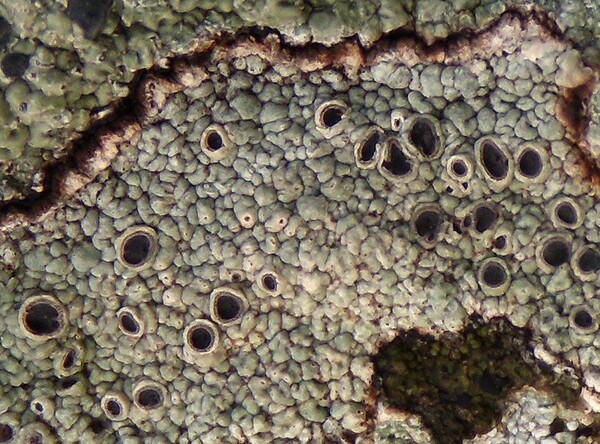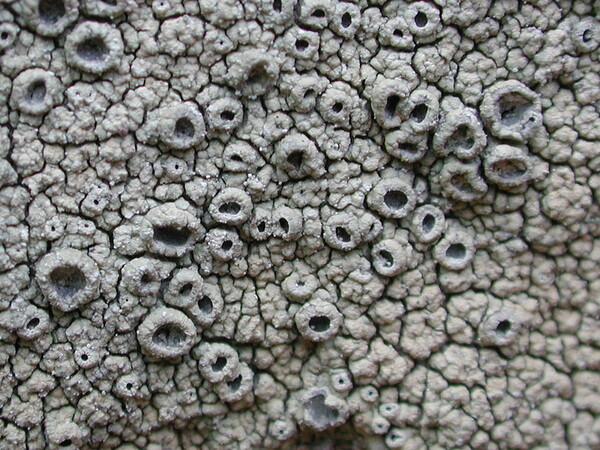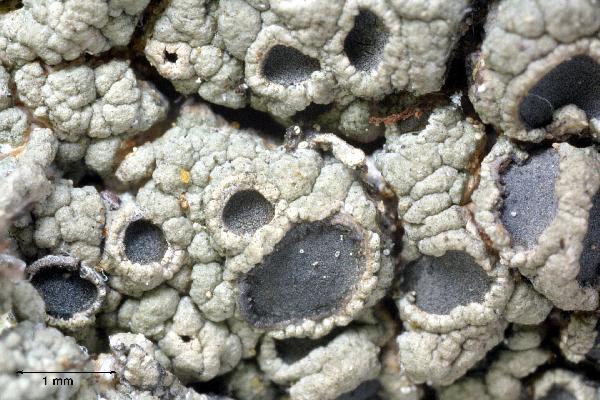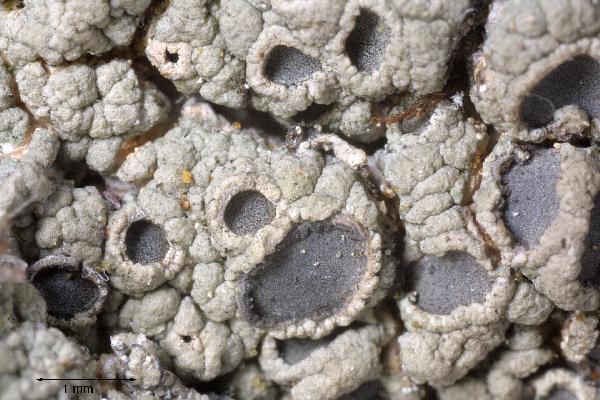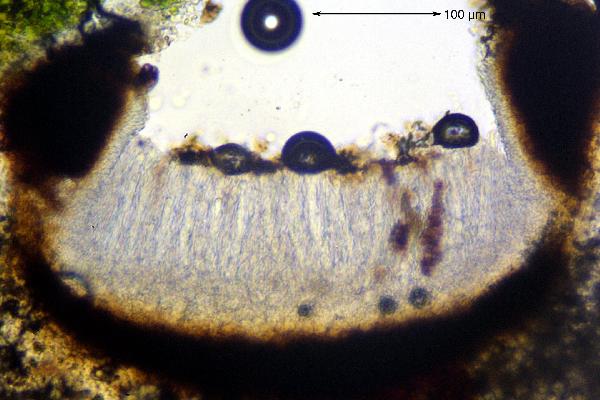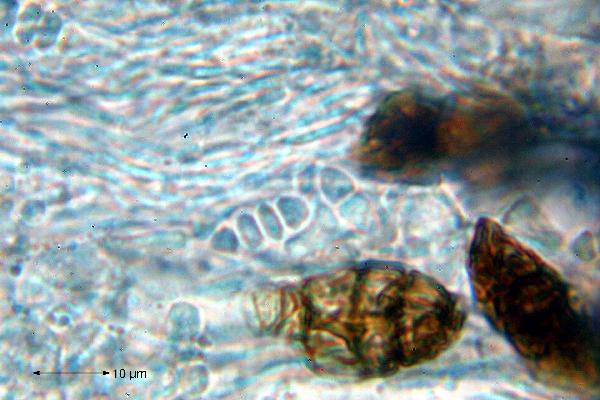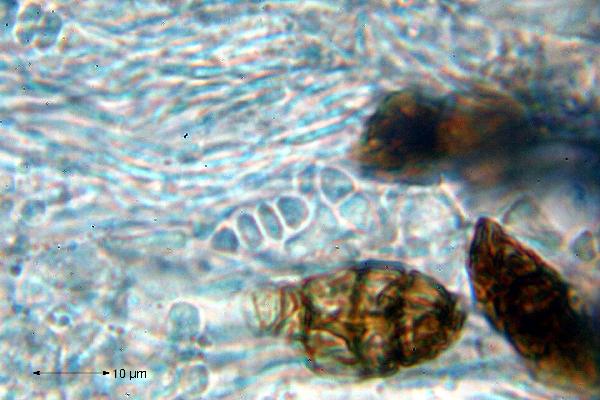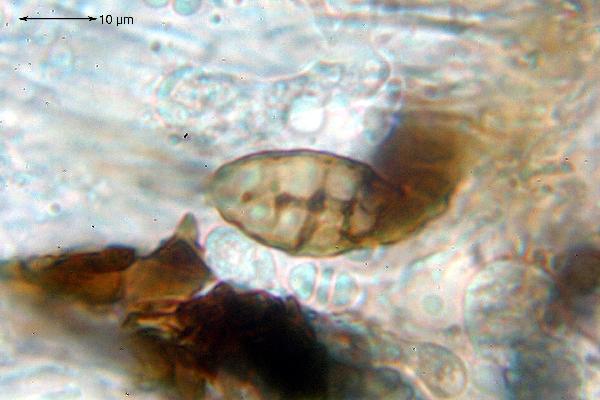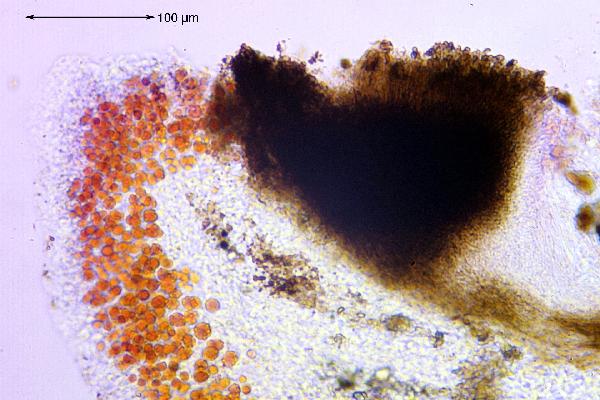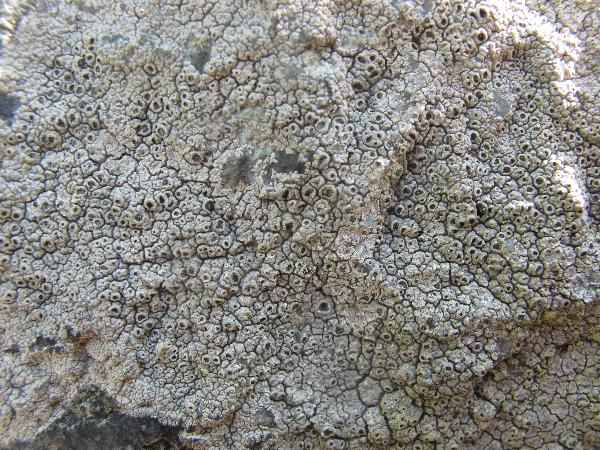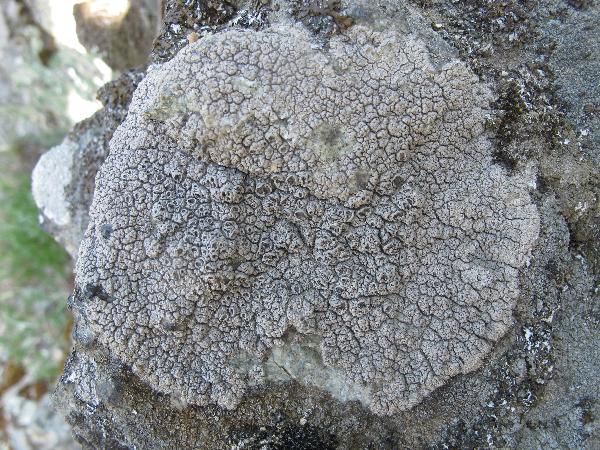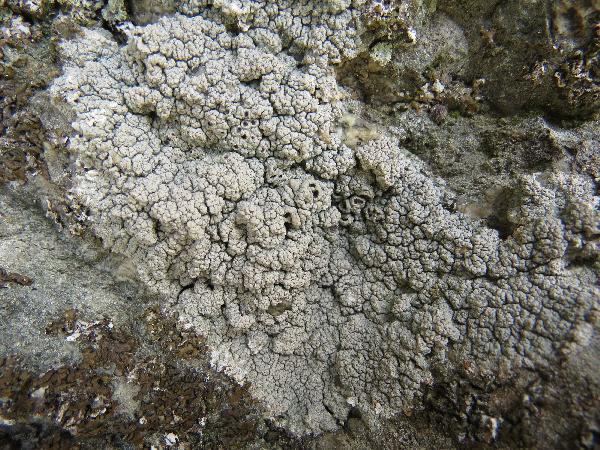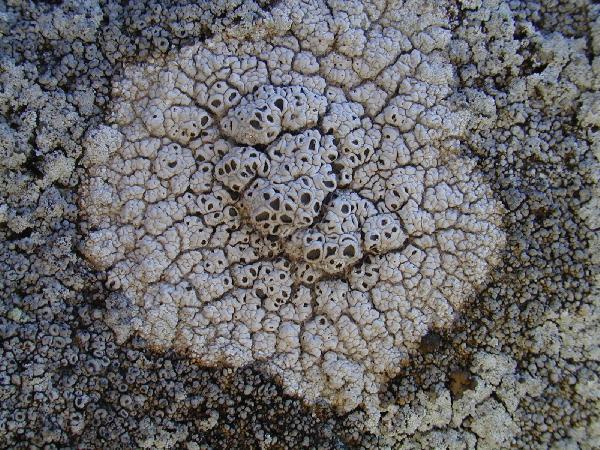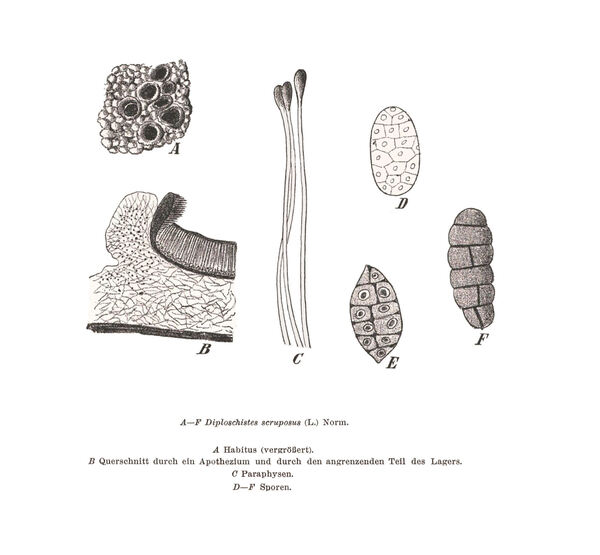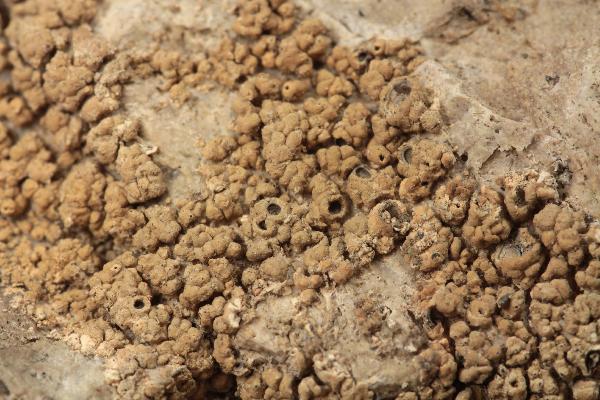Diploschistes scruposus (Schreb.) Norman
Nytt Mag. Naturvid., 7: 232, 1853. Basionym: Lichen scruposus Schreb. - Spicil. Fl. Lips.: 133, 1771.
Synonyms: Diploschistes gypsaceus subsp. interpediens (Nyl.) Clauzade & Cl. Roux; Diploschistes interpediens (Nyl.) Zahlbr.; Diploschistes ptychochrous Lettau; Diploschistes scruposus f. centrosus Werner; Diploschistes scruposus f. flavescens Zahlbr.; Diploschistes scruposus subsp. ptychochrous (Lettau) Clauzade & Cl. Roux; Diploschistes scruposus subsp. violarius (Nyl.) Clauzade & Cl. Roux; Diploschistes scruposus var. clauzadei B. de Lesd.; Diploschistes violarius (Nyl.) Zahlbr.
Distribution: N - VG, Frl (Tretiach & Hafellner 2000), Ven (Nascimbene & Caniglia 2003c, Nascimbene 2005c), TAA (Caniglia & al. 2002, Nascimbene 2001b, 2005b, 2008b, Brackel 2013), Lomb (Dalle Vedove & al. 2004, Brackel 2010), Piem (Morisi & Sereno 1995, Isocrono & al. 2004, Isocrono & Piervittori 2008, Gheza & Nascimbene 2024), VA (Borlandelli & al. 1996, Piervittori & Isocrono 1997, 1999, Piervittori & al. 2001, 2004, Matteucci & al. 2015c), Emil (Tretiach & al. 2008, Fariselli & al. 2020), Lig (Valcuvia & al. 2000, Ravera & al. 2022). C - Tosc (Pišút 1997), Marc, Umb (Panfili 2000b, Ravera & al. 2006), Laz (Bartoli 1997b, Genovesi & al. 2011, Brackel 2015), Abr, Sar (Nöske 2000, Rizzi & al. 2011, Neuwirth 2018, Brackel & Berger 2019). S - Camp (Ricciardi & al. 2000, Aprile & al. 2002, Nimis & Tretiach 2004, Catalano & al. 2016), Pugl, Bas (Nimis & Tretiach 1999), Cal (Puntillo 1996, Brackel & Puntillo 2016), Si (Czeczuga & al. 1994, 1999, Poli & al. 1995, Nimis & al. 1996b, Grillo & al. 1996, Ottonello & Romano 1997, Grillo 1998, Grillo & Caniglia 2004, Brackel 2008b, Ottonello & al. 2011, Cataldo & Minissale 2013, Puglisi & Cataldo 2019).
Description: Thallus crustose, episubstratic, continuous, rimose- to verrucose-areolate, grey or greenish to brownish grey, scabrid, dull, epruinose, sometimes with a white prothallus, the areoles, when present, irregularly angular, 0.4-1.5 mm wide and up to 3.5 mm thick, contiguous, flat to convex, often forming large patches. Medulla white, I- or I+ blue. Apothecia urceolate, semi-immersed to sessile, up to 3.5 mm across, with a black, usually slightly white-pruinose, concave disc, and a thick, raised proper margin. Proper exciple blackish, up to 75 µm thick laterally, pseudoparenchymatous; epithecium poorly differentiated, colourless to brownish; hymenium colourless, (90-)100-125(-140) µm high, non-amyloid; paraphyses simple, 1-2 µm thick, the apical cells not swollen; hypothecium dark brown, 10-15 µm high. Asci (4-)8-spored, narrowly clavate to subcylindrical, the wall evenly thickened when mature, the somewhat abrupt apical thickening with a thin, internal apical beak, lacking any apical apparatus, the contents I+ orange-red, the walls I-, not fissitunicate. Ascospores muriform, 5-7 transverse and 2-3 longitudinal septa, at first hyaline then turning brown, broadly ellipsoid, (20-)25-35(-40) x 10-18(-21) µm. Pycnidia immersed, crateriform. Conidia bacilliform, 4-6 x 1 µm. Photobiont chlorococcoid. Spot tests: thallus K-, K+ yellow, or K+ yellow turning violet red-brown, C+ red, P-, UV-. Chemistry: lecanoric acid (major), diploschistesic acid (major or absent), orsellinic acid (minor).Note: a widespread holarctic lichen found on siliceous rocks, more rarely on soil, with a wide altitudinal range. Formerly frequently confused with similar species. The species, in its present circumscription, seems to be heterogeneous (see Fernández-Brime & al. 2013).
Growth form: Crustose
Substrata: rocks
Photobiont: green algae other than Trentepohlia
Reproductive strategy: mainly sexual
Commonnes-rarity: (info)
Alpine belt: extremely rare
Subalpine belt: rather rare
Oromediterranean belt: very rare
Montane belt: rather common
Submediterranean belt: rather rare
Padanian area: very rare
Humid submediterranean belt: rather common
Humid mediterranean belt: common
Dry mediterranean belt: very rare
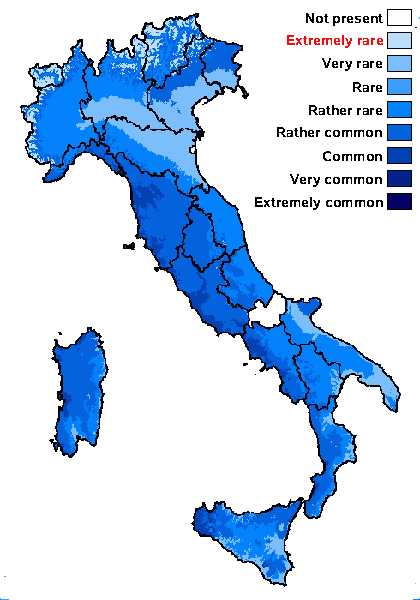
Predictive model
Herbarium samples

Ulrich Kirschbaum CC BY-SA 4.0 - Source: https://www.thm.de/lse/ulrich-kirschbaum/flechtenbilder
Spain, Canary Islands: La Gomera.
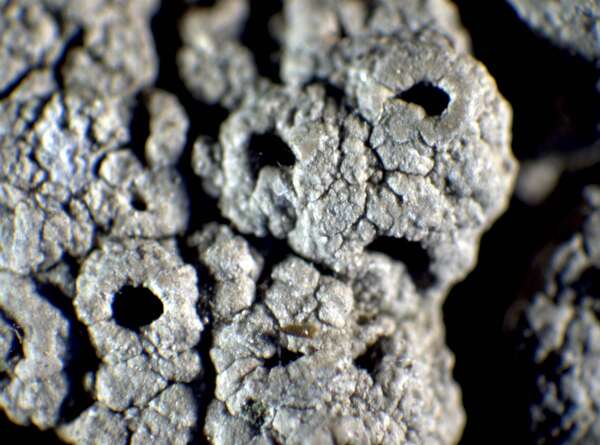

P.L. Nimis; Owner: Department of Life Sciences, University of Trieste
Herbarium: TSB (7374)
2001/11/24
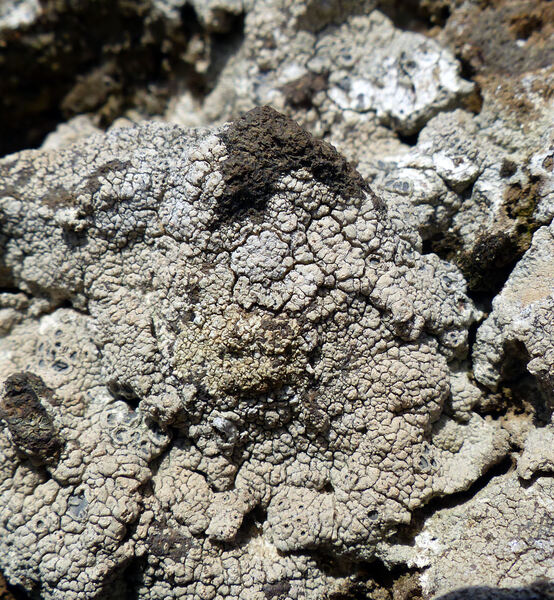

Andrea Moro; Owner: Department of Life Sciences, University of Trieste
Italy, Lazio, Roma, Ruines of ancient Tusculum, above Frascati
18/03/2017
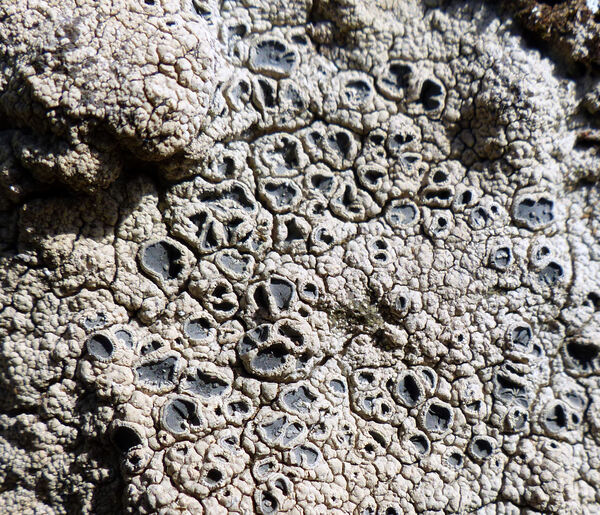

Andrea Moro; Owner: Department of Life Sciences, University of Trieste
Italy, Lazio, Roma, Ruines of ancient Tusculum, above Frascati
18/03/2017
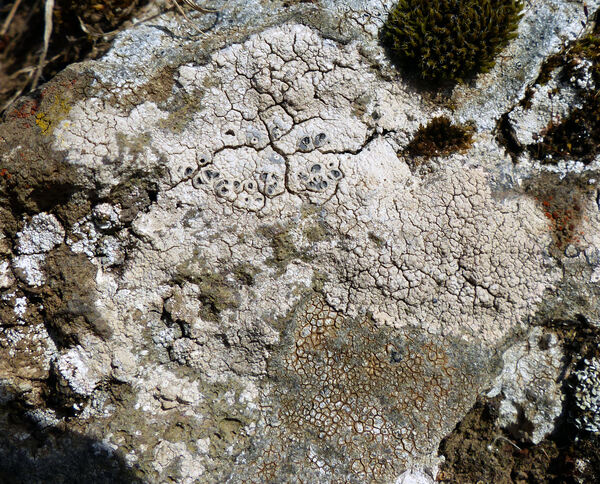

Andrea Moro; Owner: Department of Life Sciences, University of Trieste
Italy, Lazio, Roma, Ruines of ancient Tusculum, above Frascati
18/03/2017
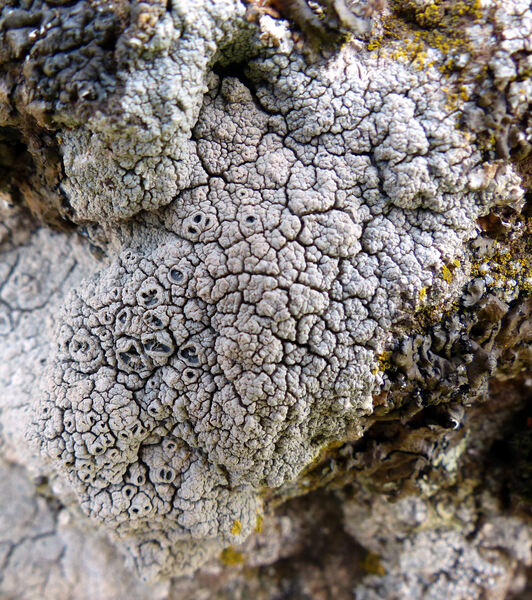

Andrea Moro; Owner: Department of Life Sciences, University of Trieste
Italy, Lazio, Roma, Ruines of ancient Tusculum, above Frascati
18/03/2017
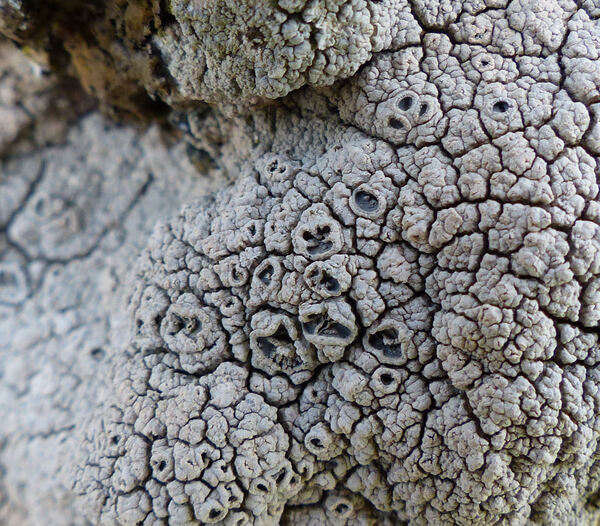

Andrea Moro; Owner: Department of Life Sciences, University of Trieste
Italy, Lazio, Roma, Ruines of ancient Tusculum, above Frascati
18/03/2017


Andrea Moro; Owner: Department of Life Sciences, University of Trieste
Italy, Lazio, Roma, Ruines of ancient Tusculum, above Frascati
18/03/2017
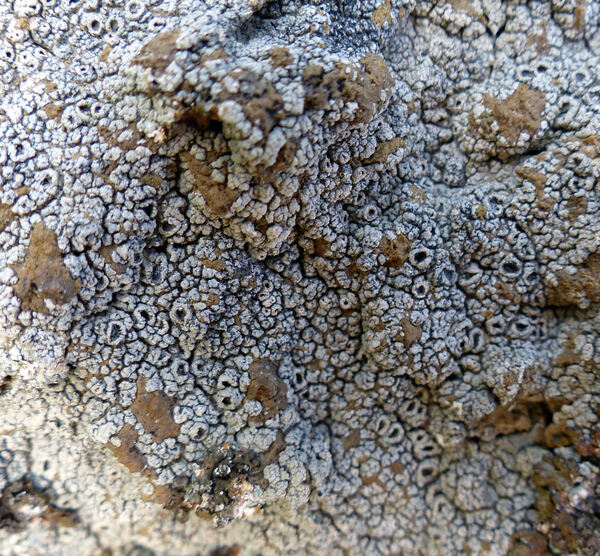

Andrea Moro; Owner: Department of Life Sciences, University of Trieste
Italy, Lazio, Roma, Ruines of ancient Tusculum, above Frascati
18/03/2017
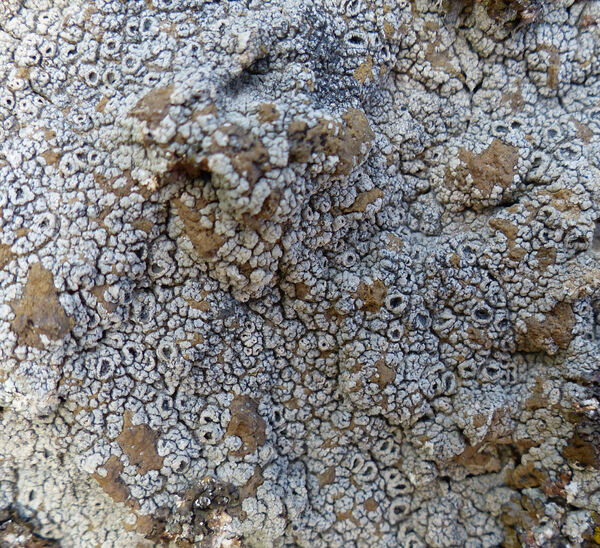

Andrea Moro; Owner: Department of Life Sciences, University of Trieste
Italy, Lazio, Roma, Ruines of ancient Tusculum, above Frascati
18/03/2017
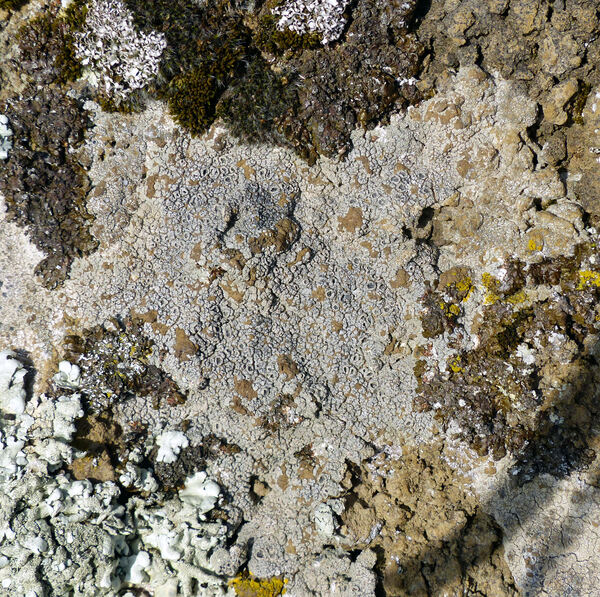

Andrea Moro; Owner: Department of Life Sciences, University of Trieste
Italy, Lazio, Roma, Ruines of ancient Tusculum, above Frascati
18/03/2017
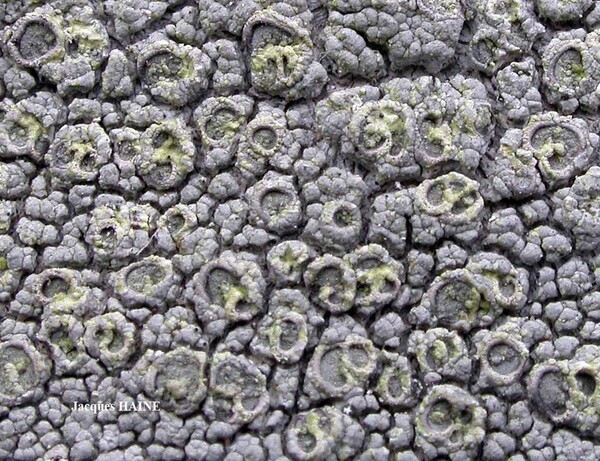
Jacques Haine - Source: http://www.lichensmaritimes.org/index.php?task=fiche&lichen=343&lang=en
France, Ardennes
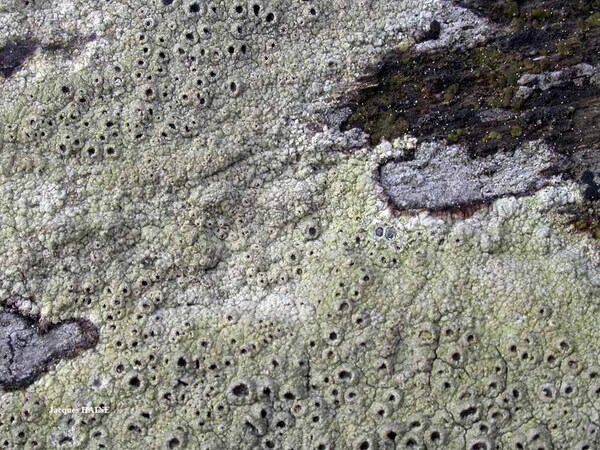
Jacques Haine - Source: http://www.lichensmaritimes.org/index.php?task=fiche&lichen=343&lang=en
France, Ardennes
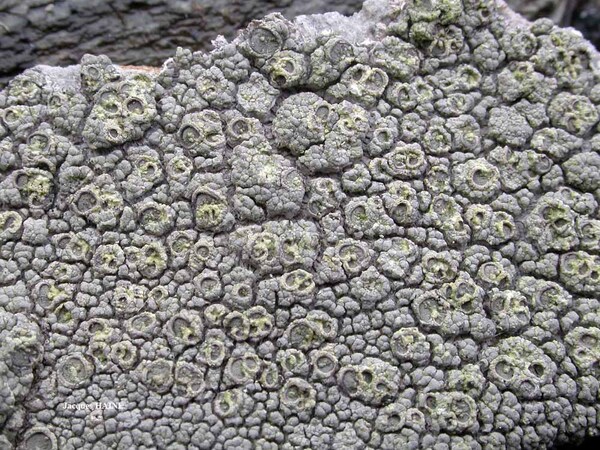
Jacques Haine - Source: http://www.lichensmaritimes.org/index.php?task=fiche&lichen=343&lang=en
France, Ardennes
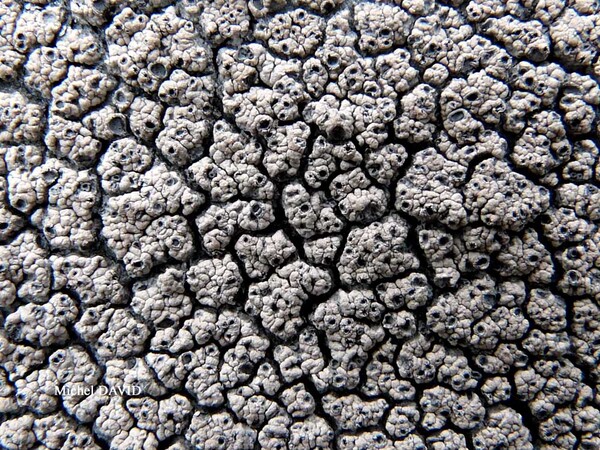
Michel David - Source: http://www.lichensmaritimes.org/index.php?task=fiche&lichen=343&lang=en
France, Commana
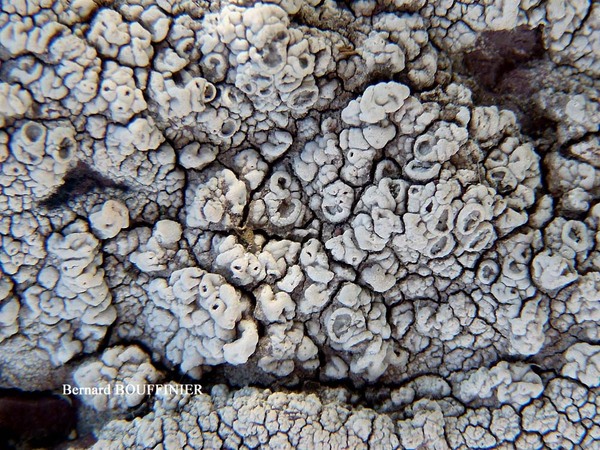
Bernard Bouffinier - Source: http://www.lichensmaritimes.org/index.php?task=fiche&lichen=343&lang=en
France, Cap de la Chèvre
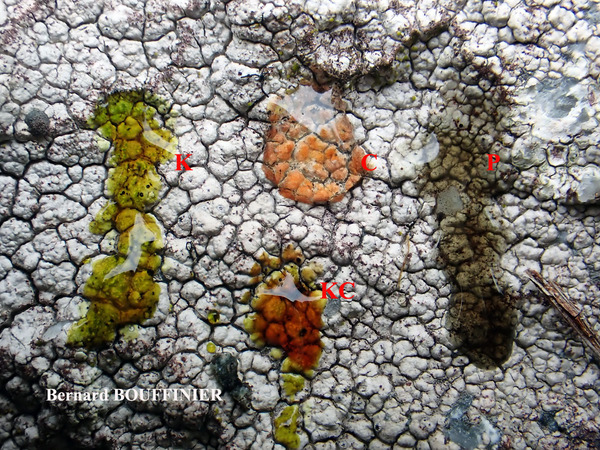
Bernard Bouffinier - Source: http://www.lichensmaritimes.org/index.php?task=fiche&lichen=343&lang=en
France, Loqueffret

Bernard Bouffinier - Source: http://www.lichensmaritimes.org/index.php?task=fiche&lichen=343&lang=en
France, Roc'h an Daol
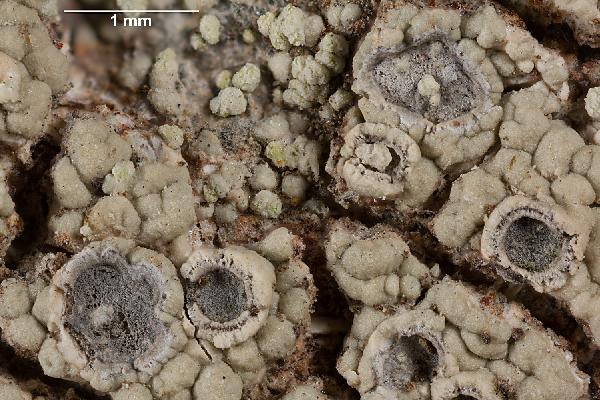
Ulrich Kirschbaum CC BY-SA 4.0 - Source: https://www.thm.de/lse/ulrich-kirschbaum/flechtenbilder
Canary Islands; E; La Gomera-MN; s of Las Rosas; s of Roque Blanco: in the vicinity of the Mirador Dinero.
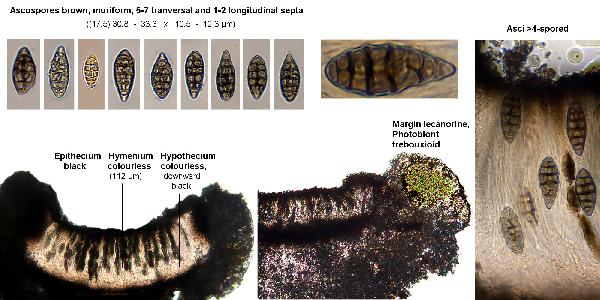
Ulrich Kirschbaum CC BY-SA 4.0 - Source: https://www.thm.de/lse/ulrich-kirschbaum/flechtenbilder
Canary Islands; E; La Gomera-MN; s of Las Rosas; s of Roque Blanco: in the vicinity of the Mirador Dinero.
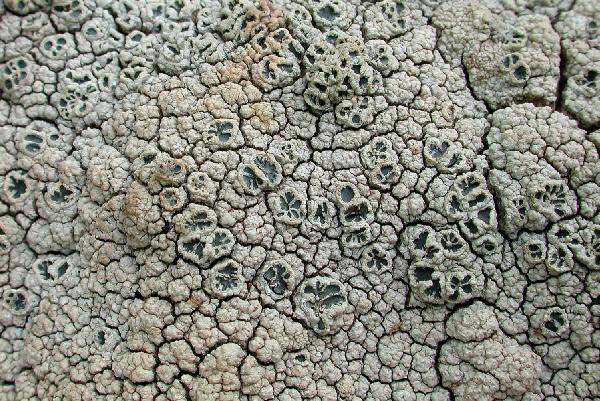
Ulrich Kirschbaum CC BY-SA 4.0 - Source: https://www.thm.de/lse/ulrich-kirschbaum/flechtenbilder
Austria: Alps (upper image).
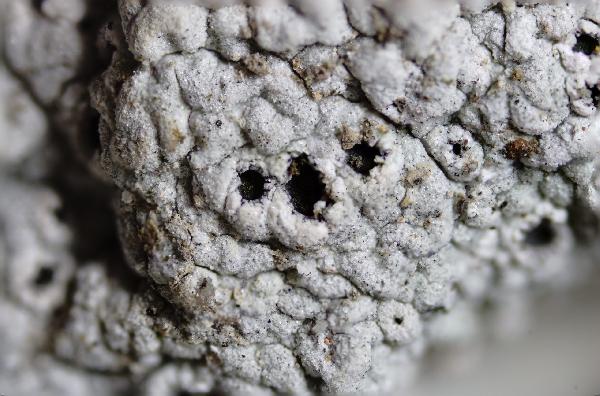
Marta González Garcia - Centro de Estudios Micologicos Asturianos
Spain, Salcedo (Quirós-Asturias), 25-V-2022, en las rocas ácidas de un muro de piedra, leg. & det. M. González, ERD-9391.
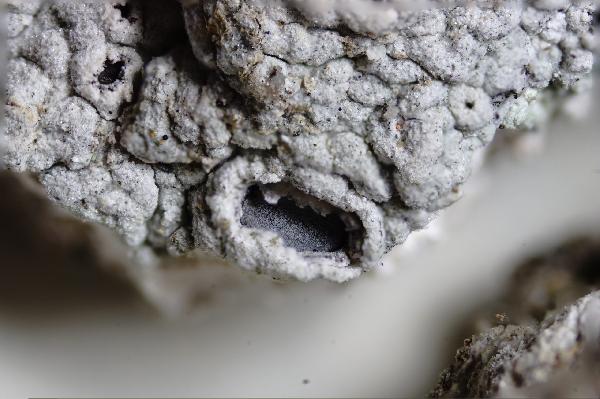
Marta González Garcia - Centro de Estudios Micologicos Asturianos
Spain, Salcedo (Quirós-Asturias), 25-V-2022, en las rocas ácidas de un muro de piedra, leg. & det. M. González, ERD-9391.
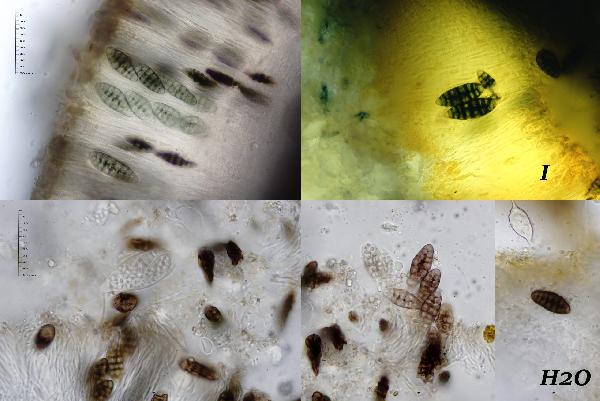
Marta González Garcia - Centro de Estudios Micologicos Asturianos
Spain, Salcedo (Quirós-Asturias), 25-V-2022, en las rocas ácidas de un muro de piedra, leg. & det. M. González, ERD-9391.
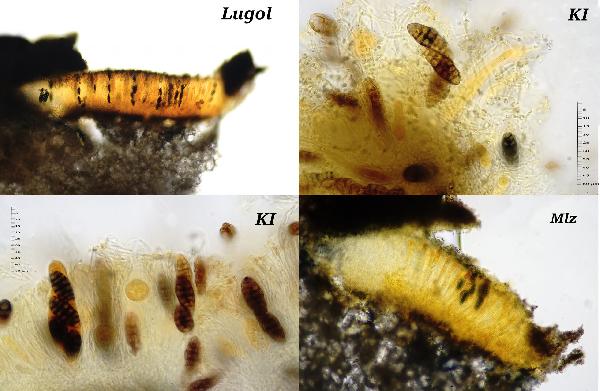
Marta González Garcia - Centro de Estudios Micologicos Asturianos
Spain, Salcedo (Quirós-Asturias), 25-V-2022, en las rocas ácidas de un muro de piedra, leg. & det. M. González, ERD-9391.
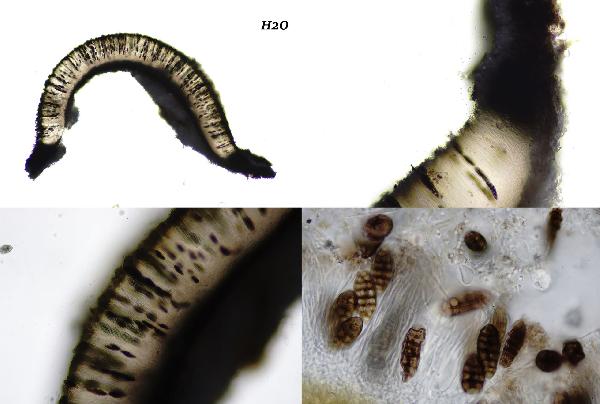
Marta González Garcia - Centro de Estudios Micologicos Asturianos
Spain, Salcedo (Quirós-Asturias), 25-V-2022, en las rocas ácidas de un muro de piedra, leg. & det. M. González, ERD-9391.
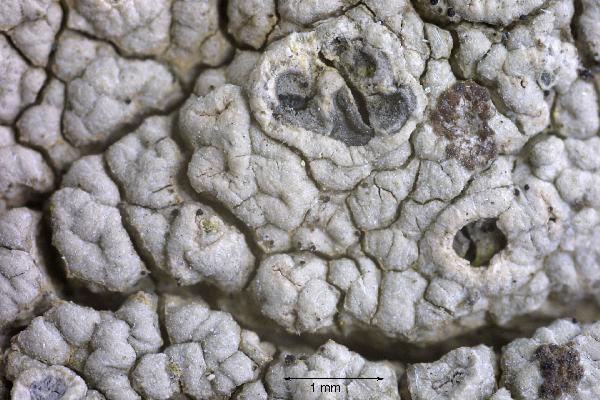

Felix Schumm - CC BY 4.0
[12321], Griechenland, N-Samos, südlich Avlakia an der Straße oberhalb
Vourliotes beim Kloster M. Vronda, 37°48' N, 26°51' E, 490 m;
Glimmerschiefergebiet. Leg. R. Düll & Maier & F. Schumm,
03.05.2006., det. F. Schumm, 06.2006. - Thallus K+ gelb dann rasch
rot, C+ rot, P-; Sporen braungrau, muriform, 27,3-28,3 x 13-14,7 μm,
zu 4-6 im Ascus.
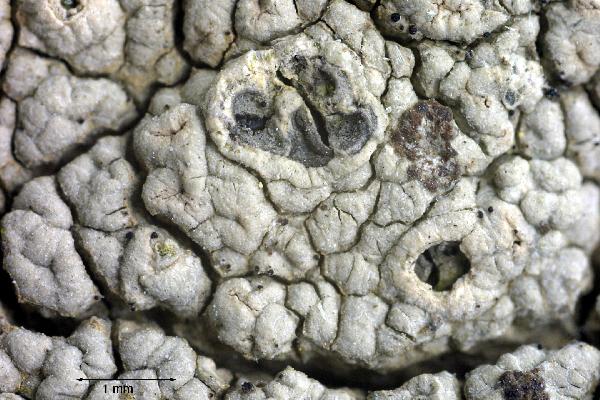

Felix Schumm - CC BY 4.0
[12321], Griechenland, N-Samos, südlich Avlakia an der Straße oberhalb
Vourliotes beim Kloster M. Vronda, 37°48' N, 26°51' E, 490 m;
Glimmerschiefergebiet. Leg. R. Düll & Maier & F. Schumm,
03.05.2006., det. F. Schumm, 06.2006. - Thallus K+ gelb dann rasch
rot, C+ rot, P-; Sporen braungrau, muriform, 27,3-28,3 x 13-14,7 μm,
zu 4-6 im Ascus.
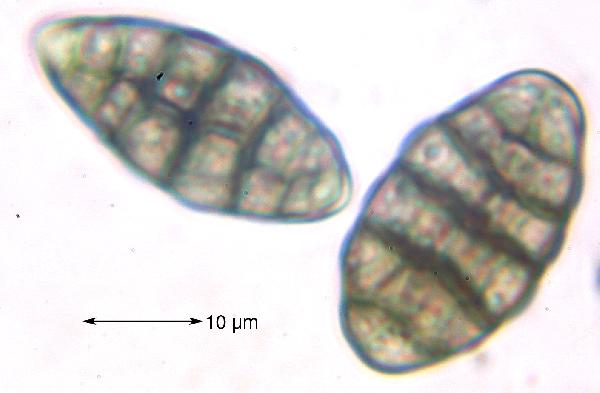

Felix Schumm - CC BY 4.0
[12321], Griechenland, N-Samos, südlich Avlakia an der Straße oberhalb
Vourliotes beim Kloster M. Vronda, 37°48' N, 26°51' E, 490 m;
Glimmerschiefergebiet. Leg. R. Düll & Maier & F. Schumm,
03.05.2006., det. F. Schumm, 06.2006. - Thallus K+ gelb dann rasch
rot, C+ rot, P-; Sporen braungrau, muriform, 27,3-28,3 x 13-14,7 μm,
zu 4-6 im Ascus.
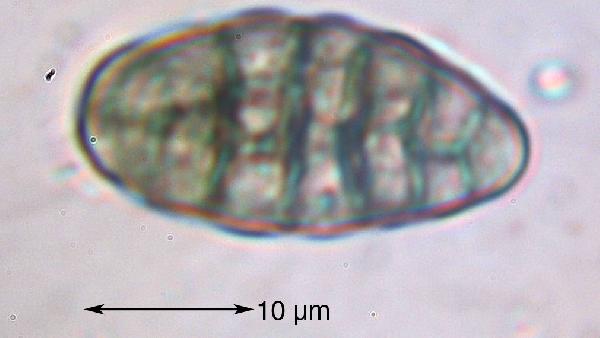

Felix Schumm - CC BY 4.0
[12321], Griechenland, N-Samos, südlich Avlakia an der Straße oberhalb
Vourliotes beim Kloster M. Vronda, 37°48' N, 26°51' E, 490 m;
Glimmerschiefergebiet. Leg. R. Düll & Maier & F. Schumm,
03.05.2006., det. F. Schumm, 06.2006. - Thallus K+ gelb dann rasch
rot, C+ rot, P-; Sporen braungrau, muriform, 27,3-28,3 x 13-14,7 μm,
zu 4-6 im Ascus.
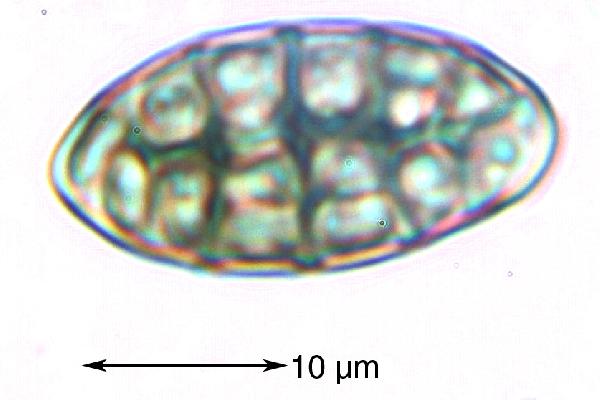

Felix Schumm - CC BY 4.0
[12321], Griechenland, N-Samos, südlich Avlakia an der Straße oberhalb
Vourliotes beim Kloster M. Vronda, 37°48' N, 26°51' E, 490 m;
Glimmerschiefergebiet. Leg. R. Düll & Maier & F. Schumm,
03.05.2006., det. F. Schumm, 06.2006. - Thallus K+ gelb dann rasch
rot, C+ rot, P-; Sporen braungrau, muriform, 27,3-28,3 x 13-14,7 μm,
zu 4-6 im Ascus.
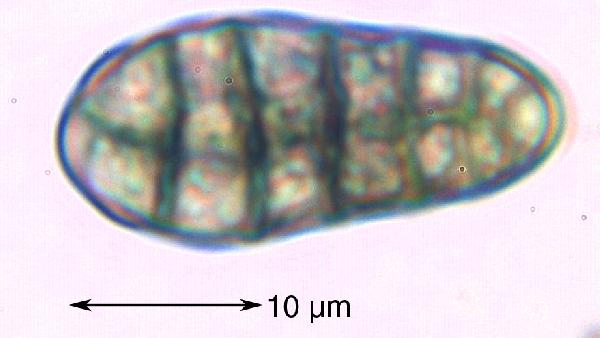

Felix Schumm - CC BY 4.0
[12321], Griechenland, N-Samos, südlich Avlakia an der Straße oberhalb
Vourliotes beim Kloster M. Vronda, 37°48' N, 26°51' E, 490 m;
Glimmerschiefergebiet. Leg. R. Düll & Maier & F. Schumm,
03.05.2006., det. F. Schumm, 06.2006. - Thallus K+ gelb dann rasch
rot, C+ rot, P-; Sporen braungrau, muriform, 27,3-28,3 x 13-14,7 μm,
zu 4-6 im Ascus.


Felix Schumm - CC BY 4.0
[15005], La Reunion, beim Kraterrand des Piton Maido, Ginster-Erica-
Gebüschvegetation mit Lavablöcken; 21,07100°S, 55,38788°E, 2090
m. Leg. F. Schumm & J.-P. Frahm, 07.09., det. F. Schumm
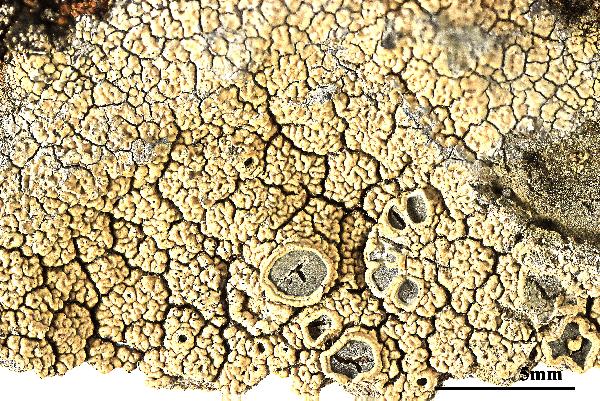

Felix Schumm - CC BY 4.0
[15005], La Reunion, beim Kraterrand des Piton Maido, Ginster-Erica-
Gebüschvegetation mit Lavablöcken; 21,07100°S, 55,38788°E, 2090
m. Leg. F. Schumm & J.-P. Frahm, 07.09., det. F. Schumm


Felix Schumm - CC BY 4.0
[19461], Germany, Hessen, Amöneburg bei Marburg, sonnige Basaltblöcke
in einer Hangwiese kurz vor dem Ortseingang, 50.7896° N,
8.91995° E, 324 m. Leg. F. Schumm, 01.08.2016, det. F. Schumm. -
Chemistry p393/7: lecanoric acid, atranorin (trace).Sporen 8/Ascus,
braun muriform.
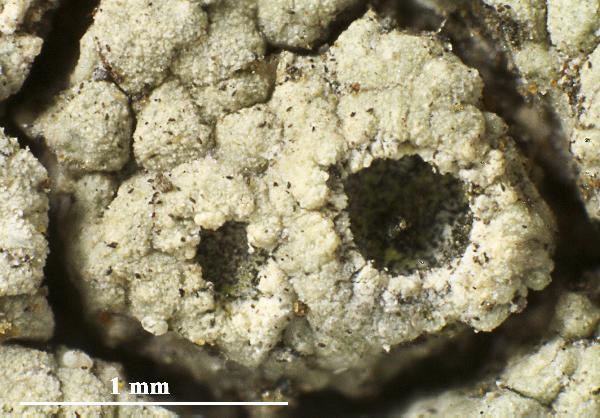

Felix Schumm - CC BY 4.0
[19461], Germany, Hessen, Amöneburg bei Marburg, sonnige Basaltblöcke
in einer Hangwiese kurz vor dem Ortseingang, 50.7896° N,
8.91995° E, 324 m. Leg. F. Schumm, 01.08.2016, det. F. Schumm. -
Chemistry p393/7: lecanoric acid, atranorin (trace).Sporen 8/Ascus,
braun muriform.
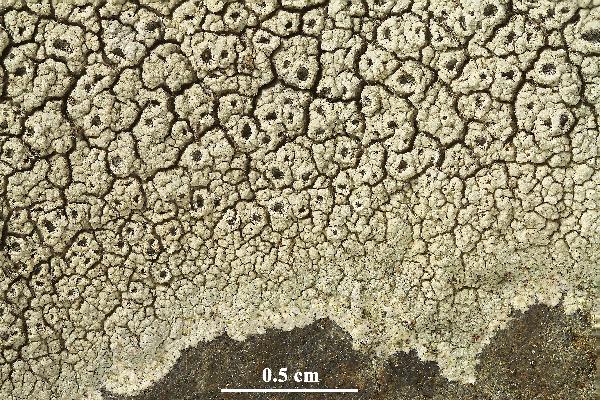

Felix Schumm - CC BY 4.0
[19461], Germany, Hessen, Amöneburg bei Marburg, sonnige Basaltblöcke
in einer Hangwiese kurz vor dem Ortseingang, 50.7896° N,
8.91995° E, 324 m. Leg. F. Schumm, 01.08.2016, det. F. Schumm. -
Chemistry p393/7: lecanoric acid, atranorin (trace).Sporen 8/Ascus,
braun muriform.
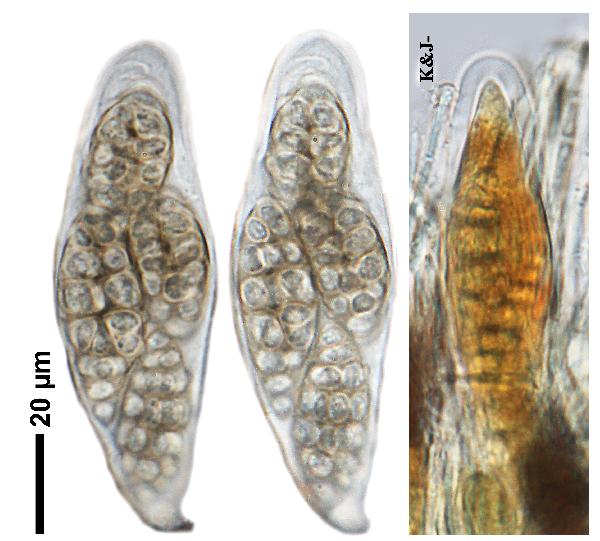

Felix Schumm - CC BY 4.0
[19461], Germany, Hessen, Amöneburg bei Marburg, sonnige Basaltblöcke
in einer Hangwiese kurz vor dem Ortseingang, 50.7896° N,
8.91995° E, 324 m. Leg. F. Schumm, 01.08.2016, det. F. Schumm. -
Chemistry p393/7: lecanoric acid, atranorin (trace).Sporen 8/Ascus,
braun muriform.
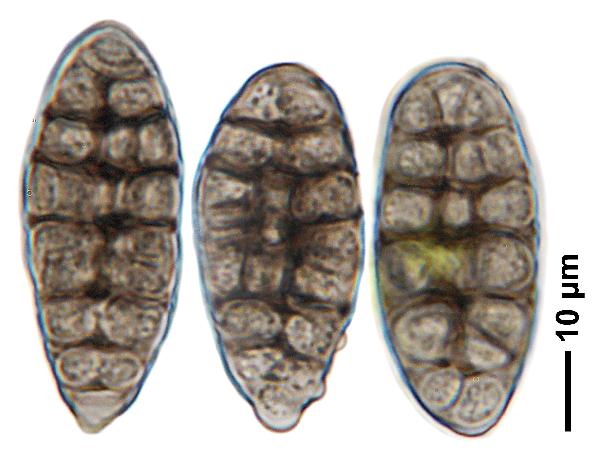

Felix Schumm - CC BY 4.0
[19461], Germany, Hessen, Amöneburg bei Marburg, sonnige Basaltblöcke
in einer Hangwiese kurz vor dem Ortseingang, 50.7896° N,
8.91995° E, 324 m. Leg. F. Schumm, 01.08.2016, det. F. Schumm. -
Chemistry p393/7: lecanoric acid, atranorin (trace).Sporen 8/Ascus,
braun muriform.
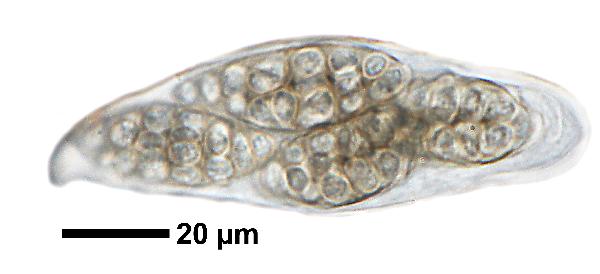

Felix Schumm - CC BY 4.0
[19461], Germany, Hessen, Amöneburg bei Marburg, sonnige Basaltblöcke
in einer Hangwiese kurz vor dem Ortseingang, 50.7896° N,
8.91995° E, 324 m. Leg. F. Schumm, 01.08.2016, det. F. Schumm. -
Chemistry p393/7: lecanoric acid, atranorin (trace).Sporen 8/Ascus,
braun muriform.
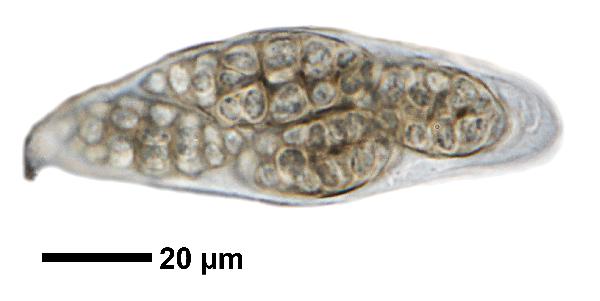

Felix Schumm - CC BY 4.0
[19461], Germany, Hessen, Amöneburg bei Marburg, sonnige Basaltblöcke
in einer Hangwiese kurz vor dem Ortseingang, 50.7896° N,
8.91995° E, 324 m. Leg. F. Schumm, 01.08.2016, det. F. Schumm. -
Chemistry p393/7: lecanoric acid, atranorin (trace).Sporen 8/Ascus,
braun muriform.
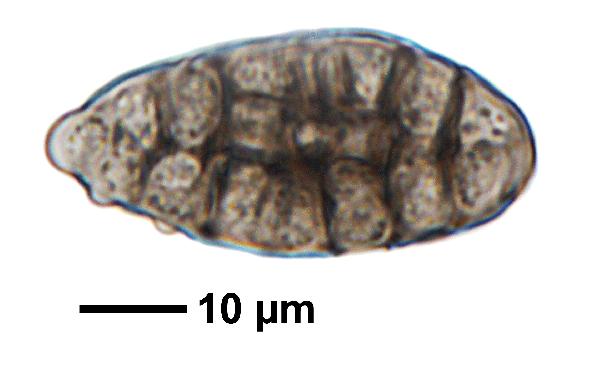

Felix Schumm - CC BY 4.0
[19461], Germany, Hessen, Amöneburg bei Marburg, sonnige Basaltblöcke
in einer Hangwiese kurz vor dem Ortseingang, 50.7896° N,
8.91995° E, 324 m. Leg. F. Schumm, 01.08.2016, det. F. Schumm. -
Chemistry p393/7: lecanoric acid, atranorin (trace).Sporen 8/Ascus,
braun muriform.


Felix Schumm - CC BY 4.0
[19461], Germany, Hessen, Amöneburg bei Marburg, sonnige Basaltblöcke
in einer Hangwiese kurz vor dem Ortseingang, 50.7896° N,
8.91995° E, 324 m. Leg. F. Schumm, 01.08.2016, det. F. Schumm. -
Chemistry p393/7: lecanoric acid, atranorin (trace).Sporen 8/Ascus,
braun muriform.
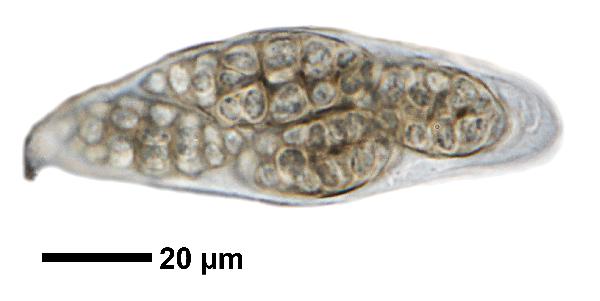

Felix Schumm - CC BY 4.0
[19461], Germany, Hessen, Amöneburg bei Marburg, sonnige Basaltblöcke
in einer Hangwiese kurz vor dem Ortseingang, 50.7896° N,
8.91995° E, 324 m. Leg. F. Schumm, 01.08.2016, det. F. Schumm. -
Chemistry p393/7: lecanoric acid, atranorin (trace).Sporen 8/Ascus,
braun muriform.
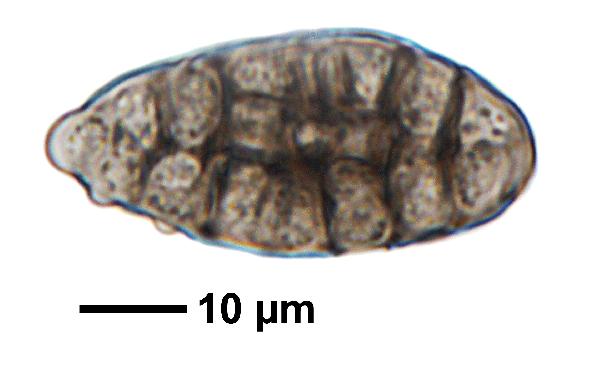

Felix Schumm - CC BY 4.0
[19461], Germany, Hessen, Amöneburg bei Marburg, sonnige Basaltblöcke
in einer Hangwiese kurz vor dem Ortseingang, 50.7896° N,
8.91995° E, 324 m. Leg. F. Schumm, 01.08.2016, det. F. Schumm. -
Chemistry p393/7: lecanoric acid, atranorin (trace).Sporen 8/Ascus,
braun muriform.
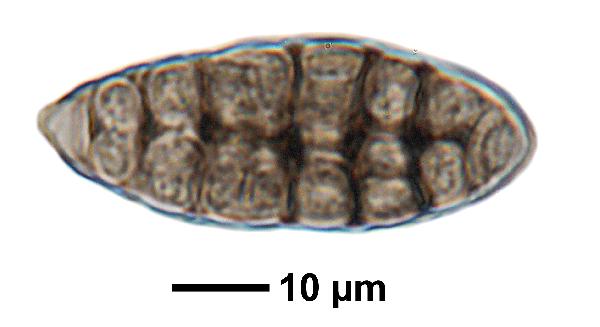

Felix Schumm - CC BY 4.0
[19461], Germany, Hessen, Amöneburg bei Marburg, sonnige Basaltblöcke
in einer Hangwiese kurz vor dem Ortseingang, 50.7896° N,
8.91995° E, 324 m. Leg. F. Schumm, 01.08.2016, det. F. Schumm. -
Chemistry p393/7: lecanoric acid, atranorin (trace).Sporen 8/Ascus,
braun muriform.
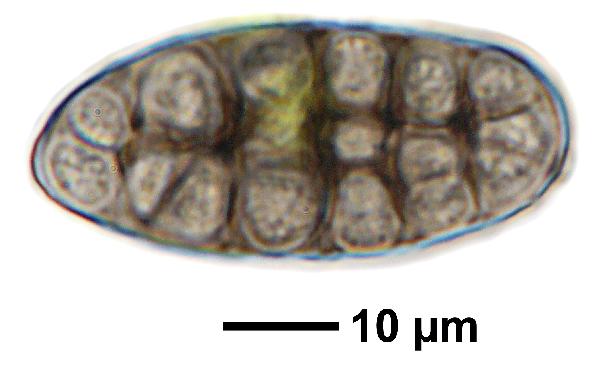

Felix Schumm - CC BY 4.0
[19461], Germany, Hessen, Amöneburg bei Marburg, sonnige Basaltblöcke
in einer Hangwiese kurz vor dem Ortseingang, 50.7896° N,
8.91995° E, 324 m. Leg. F. Schumm, 01.08.2016, det. F. Schumm. -
Chemistry p393/7: lecanoric acid, atranorin (trace).Sporen 8/Ascus,
braun muriform.


Felix Schumm - CC BY 4.0
[19461], Germany, Hessen, Amöneburg bei Marburg, sonnige Basaltblöcke
in einer Hangwiese kurz vor dem Ortseingang, 50.7896° N,
8.91995° E, 324 m. Leg. F. Schumm, 01.08.2016, det. F. Schumm. -
Chemistry p393/7: lecanoric acid, atranorin (trace).Sporen 8/Ascus,
braun muriform.


Felix Schumm - CC BY 4.0
[19461], Germany, Hessen, Amöneburg bei Marburg, sonnige Basaltblöcke
in einer Hangwiese kurz vor dem Ortseingang, 50.7896° N,
8.91995° E, 324 m. Leg. F. Schumm, 01.08.2016, det. F. Schumm. -
Chemistry p393/7: lecanoric acid, atranorin (trace).Sporen 8/Ascus,
braun muriform.
Growth form: Crustose
Substrata: rocks
Photobiont: green algae other than Trentepohlia
Reproductive strategy: mainly sexual
Commonnes-rarity: (info)
Alpine belt: extremely rare
Subalpine belt: rather rare
Oromediterranean belt: very rare
Montane belt: rather common
Submediterranean belt: rather rare
Padanian area: very rare
Humid submediterranean belt: rather common
Humid mediterranean belt: common
Dry mediterranean belt: very rare

Predictive model
| Herbarium samples |

Ulrich Kirschbaum CC BY-SA 4.0 - Source: https://www.thm.de/lse/ulrich-kirschbaum/flechtenbilder
Spain, Canary Islands: La Gomera.


P.L. Nimis; Owner: Department of Life Sciences, University of Trieste
Herbarium: TSB (7374)
2001/11/24


Andrea Moro; Owner: Department of Life Sciences, University of Trieste
Italy, Lazio, Roma, Ruines of ancient Tusculum, above Frascati
18/03/2017


Andrea Moro; Owner: Department of Life Sciences, University of Trieste
Italy, Lazio, Roma, Ruines of ancient Tusculum, above Frascati
18/03/2017


Andrea Moro; Owner: Department of Life Sciences, University of Trieste
Italy, Lazio, Roma, Ruines of ancient Tusculum, above Frascati
18/03/2017


Andrea Moro; Owner: Department of Life Sciences, University of Trieste
Italy, Lazio, Roma, Ruines of ancient Tusculum, above Frascati
18/03/2017


Andrea Moro; Owner: Department of Life Sciences, University of Trieste
Italy, Lazio, Roma, Ruines of ancient Tusculum, above Frascati
18/03/2017


Andrea Moro; Owner: Department of Life Sciences, University of Trieste
Italy, Lazio, Roma, Ruines of ancient Tusculum, above Frascati
18/03/2017


Andrea Moro; Owner: Department of Life Sciences, University of Trieste
Italy, Lazio, Roma, Ruines of ancient Tusculum, above Frascati
18/03/2017


Andrea Moro; Owner: Department of Life Sciences, University of Trieste
Italy, Lazio, Roma, Ruines of ancient Tusculum, above Frascati
18/03/2017


Andrea Moro; Owner: Department of Life Sciences, University of Trieste
Italy, Lazio, Roma, Ruines of ancient Tusculum, above Frascati
18/03/2017

Jacques Haine - Source: http://www.lichensmaritimes.org/index.php?task=fiche&lichen=343&lang=en
France, Ardennes

Jacques Haine - Source: http://www.lichensmaritimes.org/index.php?task=fiche&lichen=343&lang=en
France, Ardennes

Jacques Haine - Source: http://www.lichensmaritimes.org/index.php?task=fiche&lichen=343&lang=en
France, Ardennes

Michel David - Source: http://www.lichensmaritimes.org/index.php?task=fiche&lichen=343&lang=en
France, Commana

Bernard Bouffinier - Source: http://www.lichensmaritimes.org/index.php?task=fiche&lichen=343&lang=en
France, Cap de la Chèvre

Bernard Bouffinier - Source: http://www.lichensmaritimes.org/index.php?task=fiche&lichen=343&lang=en
France, Loqueffret

Bernard Bouffinier - Source: http://www.lichensmaritimes.org/index.php?task=fiche&lichen=343&lang=en
France, Roc'h an Daol

Ulrich Kirschbaum CC BY-SA 4.0 - Source: https://www.thm.de/lse/ulrich-kirschbaum/flechtenbilder
Canary Islands; E; La Gomera-MN; s of Las Rosas; s of Roque Blanco: in the vicinity of the Mirador Dinero.

Ulrich Kirschbaum CC BY-SA 4.0 - Source: https://www.thm.de/lse/ulrich-kirschbaum/flechtenbilder
Canary Islands; E; La Gomera-MN; s of Las Rosas; s of Roque Blanco: in the vicinity of the Mirador Dinero.

Ulrich Kirschbaum CC BY-SA 4.0 - Source: https://www.thm.de/lse/ulrich-kirschbaum/flechtenbilder
Austria: Alps (upper image).

Marta González Garcia - Centro de Estudios Micologicos Asturianos
Spain, Salcedo (Quirós-Asturias), 25-V-2022, en las rocas ácidas de un muro de piedra, leg. & det. M. González, ERD-9391.

Marta González Garcia - Centro de Estudios Micologicos Asturianos
Spain, Salcedo (Quirós-Asturias), 25-V-2022, en las rocas ácidas de un muro de piedra, leg. & det. M. González, ERD-9391.

Marta González Garcia - Centro de Estudios Micologicos Asturianos
Spain, Salcedo (Quirós-Asturias), 25-V-2022, en las rocas ácidas de un muro de piedra, leg. & det. M. González, ERD-9391.

Marta González Garcia - Centro de Estudios Micologicos Asturianos
Spain, Salcedo (Quirós-Asturias), 25-V-2022, en las rocas ácidas de un muro de piedra, leg. & det. M. González, ERD-9391.

Marta González Garcia - Centro de Estudios Micologicos Asturianos
Spain, Salcedo (Quirós-Asturias), 25-V-2022, en las rocas ácidas de un muro de piedra, leg. & det. M. González, ERD-9391.


Felix Schumm - CC BY 4.0
[12321], Griechenland, N-Samos, südlich Avlakia an der Straße oberhalb Vourliotes beim Kloster M. Vronda, 37°48' N, 26°51' E, 490 m; Glimmerschiefergebiet. Leg. R. Düll & Maier & F. Schumm, 03.05.2006., det. F. Schumm, 06.2006. - Thallus K+ gelb dann rasch rot, C+ rot, P-; Sporen braungrau, muriform, 27,3-28,3 x 13-14,7 μm, zu 4-6 im Ascus.


Felix Schumm - CC BY 4.0
[12321], Griechenland, N-Samos, südlich Avlakia an der Straße oberhalb Vourliotes beim Kloster M. Vronda, 37°48' N, 26°51' E, 490 m; Glimmerschiefergebiet. Leg. R. Düll & Maier & F. Schumm, 03.05.2006., det. F. Schumm, 06.2006. - Thallus K+ gelb dann rasch rot, C+ rot, P-; Sporen braungrau, muriform, 27,3-28,3 x 13-14,7 μm, zu 4-6 im Ascus.


Felix Schumm - CC BY 4.0
[12321], Griechenland, N-Samos, südlich Avlakia an der Straße oberhalb Vourliotes beim Kloster M. Vronda, 37°48' N, 26°51' E, 490 m; Glimmerschiefergebiet. Leg. R. Düll & Maier & F. Schumm, 03.05.2006., det. F. Schumm, 06.2006. - Thallus K+ gelb dann rasch rot, C+ rot, P-; Sporen braungrau, muriform, 27,3-28,3 x 13-14,7 μm, zu 4-6 im Ascus.


Felix Schumm - CC BY 4.0
[12321], Griechenland, N-Samos, südlich Avlakia an der Straße oberhalb Vourliotes beim Kloster M. Vronda, 37°48' N, 26°51' E, 490 m; Glimmerschiefergebiet. Leg. R. Düll & Maier & F. Schumm, 03.05.2006., det. F. Schumm, 06.2006. - Thallus K+ gelb dann rasch rot, C+ rot, P-; Sporen braungrau, muriform, 27,3-28,3 x 13-14,7 μm, zu 4-6 im Ascus.


Felix Schumm - CC BY 4.0
[12321], Griechenland, N-Samos, südlich Avlakia an der Straße oberhalb Vourliotes beim Kloster M. Vronda, 37°48' N, 26°51' E, 490 m; Glimmerschiefergebiet. Leg. R. Düll & Maier & F. Schumm, 03.05.2006., det. F. Schumm, 06.2006. - Thallus K+ gelb dann rasch rot, C+ rot, P-; Sporen braungrau, muriform, 27,3-28,3 x 13-14,7 μm, zu 4-6 im Ascus.


Felix Schumm - CC BY 4.0
[12321], Griechenland, N-Samos, südlich Avlakia an der Straße oberhalb Vourliotes beim Kloster M. Vronda, 37°48' N, 26°51' E, 490 m; Glimmerschiefergebiet. Leg. R. Düll & Maier & F. Schumm, 03.05.2006., det. F. Schumm, 06.2006. - Thallus K+ gelb dann rasch rot, C+ rot, P-; Sporen braungrau, muriform, 27,3-28,3 x 13-14,7 μm, zu 4-6 im Ascus.


Felix Schumm - CC BY 4.0
[15005], La Reunion, beim Kraterrand des Piton Maido, Ginster-Erica- Gebüschvegetation mit Lavablöcken; 21,07100°S, 55,38788°E, 2090 m. Leg. F. Schumm & J.-P. Frahm, 07.09., det. F. Schumm


Felix Schumm - CC BY 4.0
[15005], La Reunion, beim Kraterrand des Piton Maido, Ginster-Erica- Gebüschvegetation mit Lavablöcken; 21,07100°S, 55,38788°E, 2090 m. Leg. F. Schumm & J.-P. Frahm, 07.09., det. F. Schumm


Felix Schumm - CC BY 4.0
[19461], Germany, Hessen, Amöneburg bei Marburg, sonnige Basaltblöcke in einer Hangwiese kurz vor dem Ortseingang, 50.7896° N, 8.91995° E, 324 m. Leg. F. Schumm, 01.08.2016, det. F. Schumm. - Chemistry p393/7: lecanoric acid, atranorin (trace).Sporen 8/Ascus, braun muriform.


Felix Schumm - CC BY 4.0
[19461], Germany, Hessen, Amöneburg bei Marburg, sonnige Basaltblöcke in einer Hangwiese kurz vor dem Ortseingang, 50.7896° N, 8.91995° E, 324 m. Leg. F. Schumm, 01.08.2016, det. F. Schumm. - Chemistry p393/7: lecanoric acid, atranorin (trace).Sporen 8/Ascus, braun muriform.


Felix Schumm - CC BY 4.0
[19461], Germany, Hessen, Amöneburg bei Marburg, sonnige Basaltblöcke in einer Hangwiese kurz vor dem Ortseingang, 50.7896° N, 8.91995° E, 324 m. Leg. F. Schumm, 01.08.2016, det. F. Schumm. - Chemistry p393/7: lecanoric acid, atranorin (trace).Sporen 8/Ascus, braun muriform.


Felix Schumm - CC BY 4.0
[19461], Germany, Hessen, Amöneburg bei Marburg, sonnige Basaltblöcke in einer Hangwiese kurz vor dem Ortseingang, 50.7896° N, 8.91995° E, 324 m. Leg. F. Schumm, 01.08.2016, det. F. Schumm. - Chemistry p393/7: lecanoric acid, atranorin (trace).Sporen 8/Ascus, braun muriform.


Felix Schumm - CC BY 4.0
[19461], Germany, Hessen, Amöneburg bei Marburg, sonnige Basaltblöcke in einer Hangwiese kurz vor dem Ortseingang, 50.7896° N, 8.91995° E, 324 m. Leg. F. Schumm, 01.08.2016, det. F. Schumm. - Chemistry p393/7: lecanoric acid, atranorin (trace).Sporen 8/Ascus, braun muriform.


Felix Schumm - CC BY 4.0
[19461], Germany, Hessen, Amöneburg bei Marburg, sonnige Basaltblöcke in einer Hangwiese kurz vor dem Ortseingang, 50.7896° N, 8.91995° E, 324 m. Leg. F. Schumm, 01.08.2016, det. F. Schumm. - Chemistry p393/7: lecanoric acid, atranorin (trace).Sporen 8/Ascus, braun muriform.


Felix Schumm - CC BY 4.0
[19461], Germany, Hessen, Amöneburg bei Marburg, sonnige Basaltblöcke in einer Hangwiese kurz vor dem Ortseingang, 50.7896° N, 8.91995° E, 324 m. Leg. F. Schumm, 01.08.2016, det. F. Schumm. - Chemistry p393/7: lecanoric acid, atranorin (trace).Sporen 8/Ascus, braun muriform.


Felix Schumm - CC BY 4.0
[19461], Germany, Hessen, Amöneburg bei Marburg, sonnige Basaltblöcke in einer Hangwiese kurz vor dem Ortseingang, 50.7896° N, 8.91995° E, 324 m. Leg. F. Schumm, 01.08.2016, det. F. Schumm. - Chemistry p393/7: lecanoric acid, atranorin (trace).Sporen 8/Ascus, braun muriform.


Felix Schumm - CC BY 4.0
[19461], Germany, Hessen, Amöneburg bei Marburg, sonnige Basaltblöcke in einer Hangwiese kurz vor dem Ortseingang, 50.7896° N, 8.91995° E, 324 m. Leg. F. Schumm, 01.08.2016, det. F. Schumm. - Chemistry p393/7: lecanoric acid, atranorin (trace).Sporen 8/Ascus, braun muriform.


Felix Schumm - CC BY 4.0
[19461], Germany, Hessen, Amöneburg bei Marburg, sonnige Basaltblöcke in einer Hangwiese kurz vor dem Ortseingang, 50.7896° N, 8.91995° E, 324 m. Leg. F. Schumm, 01.08.2016, det. F. Schumm. - Chemistry p393/7: lecanoric acid, atranorin (trace).Sporen 8/Ascus, braun muriform.


Felix Schumm - CC BY 4.0
[19461], Germany, Hessen, Amöneburg bei Marburg, sonnige Basaltblöcke in einer Hangwiese kurz vor dem Ortseingang, 50.7896° N, 8.91995° E, 324 m. Leg. F. Schumm, 01.08.2016, det. F. Schumm. - Chemistry p393/7: lecanoric acid, atranorin (trace).Sporen 8/Ascus, braun muriform.


Felix Schumm - CC BY 4.0
[19461], Germany, Hessen, Amöneburg bei Marburg, sonnige Basaltblöcke in einer Hangwiese kurz vor dem Ortseingang, 50.7896° N, 8.91995° E, 324 m. Leg. F. Schumm, 01.08.2016, det. F. Schumm. - Chemistry p393/7: lecanoric acid, atranorin (trace).Sporen 8/Ascus, braun muriform.


Felix Schumm - CC BY 4.0
[19461], Germany, Hessen, Amöneburg bei Marburg, sonnige Basaltblöcke in einer Hangwiese kurz vor dem Ortseingang, 50.7896° N, 8.91995° E, 324 m. Leg. F. Schumm, 01.08.2016, det. F. Schumm. - Chemistry p393/7: lecanoric acid, atranorin (trace).Sporen 8/Ascus, braun muriform.


Felix Schumm - CC BY 4.0
[19461], Germany, Hessen, Amöneburg bei Marburg, sonnige Basaltblöcke in einer Hangwiese kurz vor dem Ortseingang, 50.7896° N, 8.91995° E, 324 m. Leg. F. Schumm, 01.08.2016, det. F. Schumm. - Chemistry p393/7: lecanoric acid, atranorin (trace).Sporen 8/Ascus, braun muriform.


 INDEX FUNGORUM
INDEX FUNGORUM
 GBIF
GBIF
 DOLICHENS
DOLICHENS
